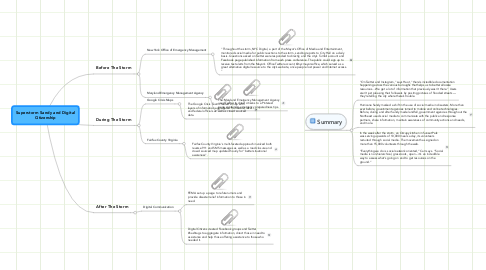
1. Before The Storm
1.1. New York Office of Emergency Management
1.1.1. "Throughout the storm, NYC Digital, a part of the Mayor’s Office of Media and Entertainment, monitored social media for public reactions to the storm, sending reports to City Hall on a daily basis. Questions asked on Twitter were responded to directly, and the city’s Tumblr account and Facebook page published information from each press conference. The public could sign up to receive text alerts from the Mayor’s Office Twitter account, @nycmayorsoffice, which served as a great alternative digital resource to the city’s website, once people lost power and Internet access. "
1.2. Maryland Emergency Management Agency
1.2.1. The Maryland Emergency Management Agency used Twitter to direct citizens to a Pinterest page containing emergency preparedness tips.
2. During The Storm
2.1. Google Crisis Maps
2.1.1. The Google Crisis Team created a map with layers of information aggregated from state, local and federal officials as well as crowd sourced data.
2.2. Fairfax County Virginia
2.2.1. Fairfax County Virginia's multi-faceted approach involved both reverse 911 and SMS messages as well as a road closure and crowd sourced map updated hourly for "better situational awareness".
3. After The Storm
3.1. Digital Communication
3.1.1. FEMA set up a page to refute rumors and provide disaster relief information to those in need.
3.1.2. Digital Citizens created Facebook groups and Twitter #hashtags to aggregate information, direct those in need to assistance and help those offering assistance to those who needed it.
